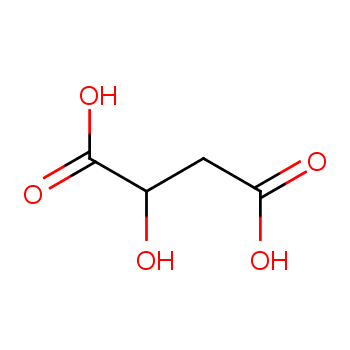-

L-(-)-Malic Acid
- CAS:97-67-6
- MW:134.09
- MF:C4H6O5
Active ingredient in many sour or tart foods.
 |
Active ingredient in many sour or tart foods.
L-Malic acid is nearly odorless (sometimes a faint, acrid odor). This compound has a tart, acidic, nonpungent taste. clear colourless solution
OtherSolid|Solid|white crystalline powder, granules, or needles; acid taste; odourless or having a very faint caramellic acrid odour and a tart aciduous taste
(S)-malic acid is an optically active form of malic acid having (S)-configuration. It is a conjugate acid of a (S)-malate(2-). It is an enantiomer of a (R)-malic acid.
Active ingredient in many sour or tart foods.
Hazard Codes:? Xi
Xi
Risk Statements: 36/37/38?
R36/37/38:Irritating to eyes, respiratory system and skin.
Safety Statements: 26-36-37/39?
S26: In case of contact with eyes, rinse immediately with plenty of water and seek medical advice.?
S36:Wear suitable protective clothing.?
S37/39:Wear suitable gloves and eye/face protection.
WGK Germany: 3
RTECS: ON7175000
HS Code: 29181980
Storage
It should be stored in a tightly closed container and keep container closed when not in use. It should be stored in a cool and dry area away from incompatible substances.
Handling
Wash thoroughly after handling.Avoid contact with eyes, skin, and clothing. Remove contaminated clothing and wash before reuse. Wash clothing before reuse. Avoid ingestion and inhalation. Use with adequate ventilation.
Personal Protection
Wear appropriate protective chemical safety goggles or eyeglasses. Wear appropriate protective gloves to prevent skin exposure.Wear suitable protective clothing to prevent skin exposure.
Small spills/leaks
Clean up spills right away, using the suitable protective equipment. Sweep up, then place into a container for disposal. Avoid generating dusty conditions. Provide ventilation.
| precursor: |
| product: |